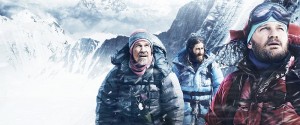Everest
Everest, 2015, 4 ¼ stars
The cinematic summit
Everest rises above similar films
From The Orlando Weekly, September 23, 2015
Everest, the ambitious new IMAX action-adventure by Icelandic director Baltasar Kormákur, is everything you hoped for. An amazing union of spectacle and story, it’s the year’s first true cinematic experience.
Written by William Nicholson and Simon Beaufoy, this is the true story of the tourism industry that sprouted on Mount Everest in the 1990s, when hundreds of ordinary people were first able to experience the world’s tallest mountain. Specifically, Everest recounts the deadly blizzard that struck in May 1996, threatening the lives of employees and guests of two rival tour companies – one led by New Zealander Rob Hall (Jason Clarke) and the other by American Scott Fischer (Jake Gyllenhaal).
To tell this gripping tale, the film’s crew – led by cinematographer Salvatore Totino (Cinderella Man, The DaVinci Code) – dragged IMAX cameras onto Everest, capturing breathtaking images from both ground and air. Though the actors themselves never made the summit, they did film at several lower locations, including the 17,000-foot base camp, and also in the Italian Alps, where they were subjected to brutal weather. And though the film uses CGI, it’s balanced well with traditional effects, leading to several “how did they do that?” moments.
The film is dramatically competent too, eschewing the sappy, contrived characterizations of Airport and The Poseidon Adventure. Still, in many ways, Everest harkens back to 1970s disaster films, just with smarter editing, more believable performances and better visuals. It admittedly wouldn’t be as impressive on the small screen, but, yes, it could survive on story alone, and that sets it apart from similar action flicks. It evokes emotion while never dwelling too long on tragedy, preferring to push the pace, as the climbers themselves had to if they wanted to survive.
The ending seems a tad rushed, and not all the characters are fully fleshed out, but it would have taken a three-hour movie to accomplish that. Instead, we get brief but illuminating glimpses into their lives and personalities. There’s the overconfident, slightly brash party dude (Gyllenhaal); the stoic Russian (Ingvar Eggert Sigurðsson); the journalist (Michael Kelly, of House of Cards fame); the sympathetic everyman attempting one last try at the mountain (John Hawkes); and the heroic, loyal leader (Clarke, in a strong turn).
Adding quieter, subtler moments are the magnificent Keira Knightley as Rob’s pregnant wife, Emily Watson as base-camp manager and Robin Wright as a spunky wife. For a dose of Texan toughness, there’s my favorite: Beck Weathers, played well by Josh Brolin, although his “Dole/Kemp 1996” t-shirt is four months early. And then there’s the real star, the mountain itself, which dominates almost every frame in a way that another inanimate object (a boat) did in a similarly grand disaster film from James Cameron.
These characters may sound like stereotypes, but they aren’t. They feel genuine, helped along by the 3-D IMAX experience, which makes you feel like you’re there. One got a similar feeling watching the 1998 IMAX documentary, also titled Everest, but Kormákur’s movie places you not just on the mountain but inside a story, inside characters’ heads and inside human bodies as oxygen levels drop and extremities freeze. And that’s a heretofore unaccomplished feat for this type of IMAX film.
“I just felt like we should do everything that we could possibly do with the elements,” Kormákur told Variety. “The more that we make the Marvel studio films – fantastic for what they are – the more we need to contradict that and make films that feel real.”
For that thrilling dose of realism, see this film now, and see it in 3-D IMAX. It’s the next-best thing to actually climbing a mountain.
2015 Orlando Weekly / MeierMovies, LLC
